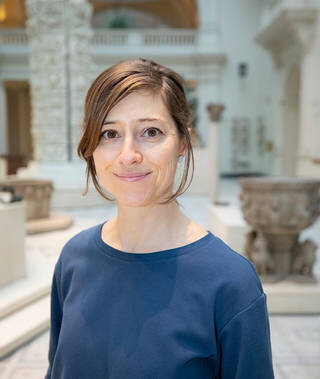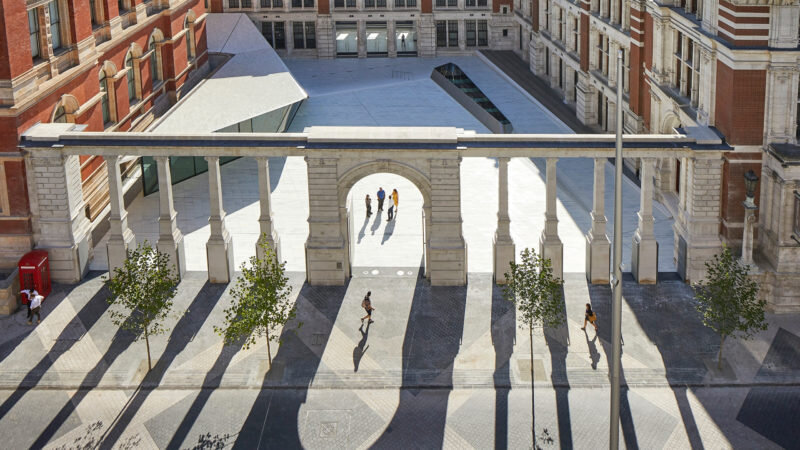INTERVIEW: Pip Simpson, V&A
In the months leading up to the pandemic, we worked with the V&A on an exciting new temporary exhibition. But just as it was about to launch, Covid-19 restrictions came into play and all museums and galleries in the UK were closed. With the V&A set to reopen its doors on August 6th, we interviewed the V&A’s Director of Design, Estate & FuturePlan, Dr Pip Simpson, to see how the V&A are approaching the return of visitors in a post-pandemic world.
GA: With restaurants and even gyms beginning to reopen across the UK, it’s likely that cultural attractions will reopen at some point in the near future. Can you share how the V&A are approaching the return of visitors in a post-pandemic world?
We have been planning carefully for our reopening, almost since closing, and we have now set the date for 6th August. Naturally our priority has been getting in place everything we can to keep our staff and visitors safe – making masks and hand sanitiser available throughout the building, introducing extra cleaning, reducing capacity so everyone has plenty of space to keep their distance, increasing fresh air flow.
But it has also been important to remember that a visit to the V&A should be full of joy and wonder. People have been looking at the same few walls – and the same tired objects – for months. As a free public site, we want to offer people a moment to escape, to see beauty from every part of the world.
GA: In your opinion, what will be the most significant long-term impact of this pandemic on the museum visitor experience? Will VR have an increasing role to play?
That is a really interesting question. Even before the pandemic, the possibilities of VR were really just beginning to emerge in earnest, particularly in the last two years. I think there is certainly a role here as an alternative to overseas travel – which in itself could have seismic consequences for on-site audience demographics, as they become more local and potentially younger.
However, I think we may find that the appetite for authentic, physical objects will increase after months on screen. If work, meetings, even socialising are going to become ever more virtual, we could find that the strength of the museum lies in precisely the opposite direction.
VR as armchair tourism seems like a growing field, but within galleries (especially where headsets and equipment would need to be shared) I think we could actually see its use decline in the short term.
GA: We know that you have a passion for historical arts. Do you agree with the viewpoint that the best visitor experience is a ‘physical’ interaction with an artefact/object, and do you think that viewpoint is changing, especially among the digital generation?
I have a passion for historic, modern and contemporary culture – some of which is born digital! I think the best experience as a viewer is to have direct access to an original object or piece – but that can take many forms. Seeing a physical object in a museum is already an act of decontextualization in most cases, seeing it on screen is another step removed. We don’t realise how much we ‘see’ through our other senses, even if we cannot touch. Intuitively sensing texture and weight, sound and smell, all play a part in understanding an object. If something was made to be held or used, as so many of our collection was, then having a physical proximity, even if you cannot interact directly, gives a far greater sense of what it meant or how it felt for those who made and used it.
GA: How does the V&A select the themes/subjects upon which to base its temporary exhibitions?
One of the beauties of the V&A is the breadth of its remit. Art, design and performance covers almost anything you care to imagine, which makes selecting exhibitions a joy – but not easy! We try to strike a balance so that all our visitors can see something of interest to them, but also discover something new.
Only at the V&A would you find exhibitions stretching from medieval embroidery to Videogames, Dior to Plywood.
Part of the hugely popular Dior exhibition at the V&A, 2019
Because exhibitions take up to three or four years to develop we have to be careful to select themes that are not of fleeting relevance, but equally we want to remain responsive to current concerns, so we try to remain flexible in order to accommodate unexpected opportunities.
GA: Public engagement can be useful for designing exhibitions. Do you have any examples of when public engagement significantly impacted on the final design of an exhibition?
This has been an area of increasing interest for us. Our major capital project at the Museum of Childhood has been developed in collaboration with the public (children, schools, families, teachers) from its inception, with them working through ideas for three permanent galleries, studio spaces and the main central hall and café. It has been an invaluable process, I hope in both directions as the design process will have been new for many of them. Many of those involved had never visited the museum before, many knew and loved it, and we were overwhelmed with possibilities. What came through most clearly was the need for museums to be joyful, and to be for everyone. The impact of their involvement is in every bit of the final scheme – from the objects we’re showing to the colour palette of the finishes.
GA: As a public sector institution, how do you balance cost and quality to ensure best value on your projects?
This is a difficult question, as each project is different. Our funding comes from a range of sources – donors, sponsors, revenue and grant in aid from the government (which only accounts for a third of the total) – so we feel a strong sense of responsibility towards the public and those who support us. We are rigorous in how we manage our budgets, and encourage innovation throughout our staff and consultants to find ways of maximising the impact of what we spend. I think that everyone who works for or with the V&A feels a sense of privilege but also of accountability, and does all they can to get the best for the museum. We are pretty uncompromising if I’m honest! But equally we are well experienced in prioritising and knowing where we can cut back without adversely affecting the experience. I won’t say there isn’t some smoke and mirrors, but it is deployed very cleverly…
GA: What exhibition would you personally love to see happen at the V&A?
I’ve always wanted to see a graffiti – or “street art” – exhibition. There is so much incredible work to be found outside the museums and galleries.
There are issues with bringing it into the ‘establishment’ but I also think it would be great to introduce a new audience to what is happening.




